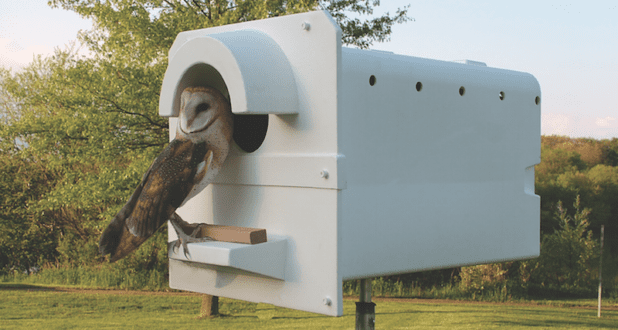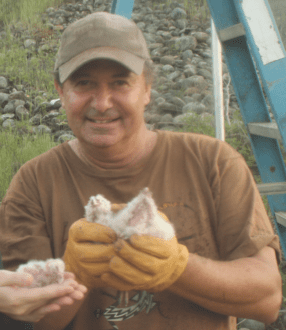

Oct 10, 2019Raptors an ally in rodent management
From barn owls to kestrels, raptors are friends in the fight against rodents that make their homes in orchards, vineyards and fields of berry bushes.
While it won’t replace commonsense tactics like mowing between the vines, bushes or trees, it’s another “tool in the toolkit” or strategy for taking rodents out of the population, said Catherine Lindell, an associate professor in Michigan State University’s Department of Integrative Biology.
“You’re going to have to use a variety of techniques, most likely, to manage rodents,” she said.
Lindell was part of a 2014 experiment to see how much kestrel boxes and artificial perches helped to knock down rodent and pest bird populations in Michigan sweet cherry orchards. Barn owl boxes are often purchased for California vineyards, according to a vendor. And a USDA National Resources Conservation Services (NRCS) newsletter once featured a Washington state grower who built a barn owl box, kestrel box and a perch pole to control the mice, pocket gophers and voles in her cherry orchard. The grower received government funding for the project through NRCS’ Environmental Quality Incentives Program, and succeeded in attracting barn owls to the location, according to the newsletter.
But before embarking on attracting wild predators to your growing operation, it’s good to do your homework, first.
“When you’re talking about trying to attract predators like kestrels or barn owls, it’s going to depend a lot on where you are,” Lindell said. While barn owls do occasionally venture up into southern Michigan, they are more prevalent in the western and southern states. Kestrels – North America’s smallest raptor – are thought to be declining as a species but are helped by the presence of nesting boxes. They often summer in the northern states and winter in the southern states or Central America, according to Cornell University.
Lindell’s data on the kestrel control of vertebrates hasn’t yet been published, but “we think kestrels can be part of a rodent management strategy,” she said.
Her team also found the prevalence of the birds can vary widely even within a state. Lindell said 80%-90% of the boxes they built in northwest Michigan’s Leelanau County locations were occupied by kestrels, compared to 20%-30% in the blueberry fields of southwest Michigan.
While there may be some food safety concerns about having wild animals of any type in an orchard or vineyard, Lindell tried to put that in perspective.
“To have, for example, a pair of kestrels or a pair of barn owls on your property – that’s two individual organisms,” she said. “But if they’re keeping out 100 pest birds or keeping out 50 pest mammals, reducing your pest birds and pest mammals, that is, of course, a better cost-benefit ratio. You end up with fewer pest mammals and birds overall than if you didn’t have this one pair of predatory animals. That’s kind of the complexity of it.”


Mark Browning is the designer of a commercial box for barn owls (pictured above) sold at www.barnowlbox.com. He said barn owl boxes have been used in California for decades – specifically in winegrape vineyards to control Botta’s pocket gophers and voles.
“It’s surprisingly widespread because it can be viewed as exotic,” he said.
A study that Browning was involved with from 2011-2013 examined 24 barn owl boxes on a 100-acre vineyard near Sacramento, California. A paper he co-authored for the Vertebrate Pest Conference estimated the total number of rodents taken over the three breeding seasons was 30,020. The number of breeding pairs of owls fluctuated from year to year, but in 2012, 18 of the 24 boxes were populated by barn owls and 66 fledgling owls were hatched.
He noted a benefit of the barn owls specifically is that multiple breeding pairs can tolerate each other’s presence and so many of them may nest in a given area.
“Barn owls, unlike most other raptors, are not territorial,” he said. They also tolerate humans remarkably well. “They maintain a healthy respect for humans, but in the same aspect, they’re unusual in that they seek out human (made) habitations.”
The barn owl boxes can be attached to barns, poles or trees. Trees create more of a risk for the nests being raided by raccoons or opossums.
A 2016 study by Sara M. Kross of Columbia University studied barn owl diets in the central valley of California and found almost all of their prey were agricultural pests.
Browning sees barn owls as being a more selective and gentle form of control than poison or blowing up tunnels.
“One of the great offshoots of using natural rodent control, versus strychnine or use of explosive gasses in the tunnels, is that those are very non-discriminatory with what they kill,” he said. “By moving away from scorched-earth methods of rodent control, you save so many species of animals that U.S. Fish and Wildlife and the state biologists are so concerned about maintaining. California is one of the most biodiverse regions in the world, and it contains a good number of threatened and endangered species, many of which find their homes and make their homes in the burrows of rodents.”
— Stephen Kloosterman, associate editor














